The SEO world is not what it used to be. No, it's not because of increased competition or the fact that if you open up your email or LinkedIn DMs, there's a million people peddling SEO services and commoditizing the market. It's really because of what's happening with Google as a product.
Let me show you what I mean...
There is a Brutal Reality In Today's Google SERPs
Let's take a look at a few examples to really drive my point home. If I type in "buy Playstation 5" into Google, what do I see?
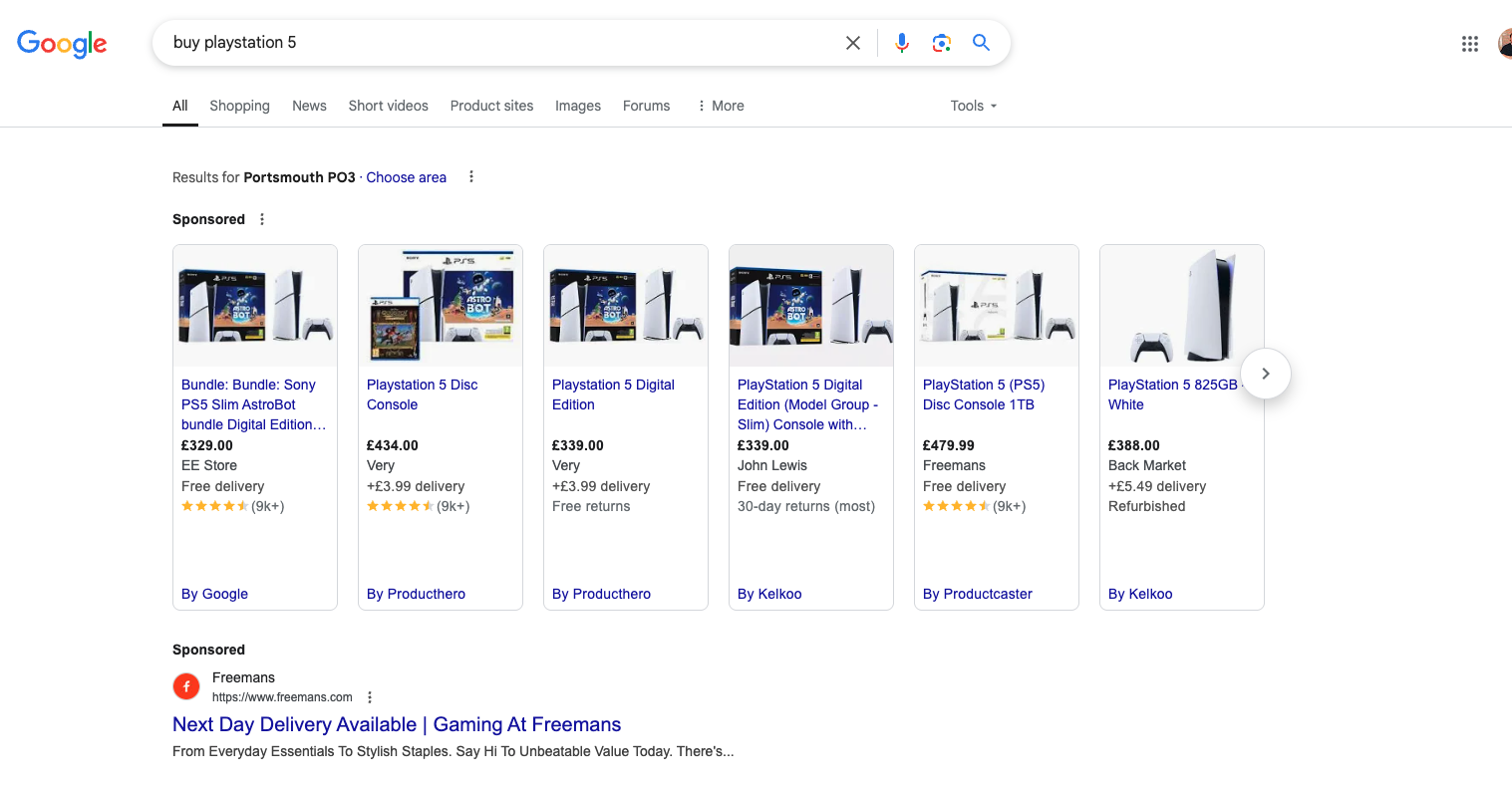
For Google, they will of course say its about the user experience, but in reality it is all about the money!
As you can see, the entirety of the above the fold content are paid advertisements. Of course, Google is showing its users what they are looking for but they are monetizing the eyeballs to the highest bidder. Google knows that users want to see great deals for searches like this and the advertisers know this as well. Its win win for both the advertiser and Google. The advertiser has a better chance of making a sale providing the product is exactly what they are looking for and Google has monetized that user.
When I scroll again I see this:
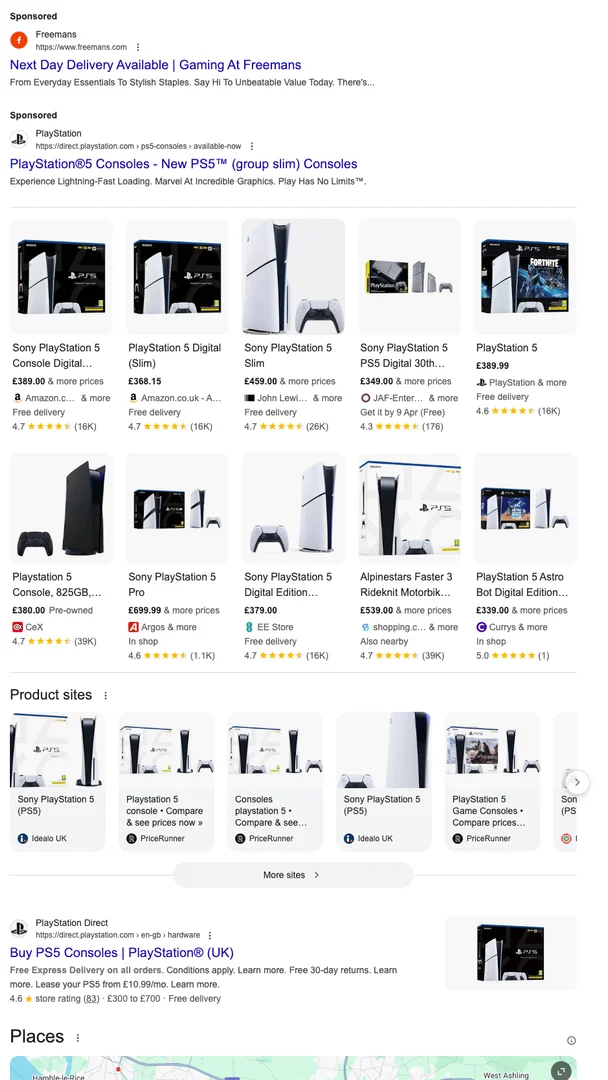
But look at the results themselves:
- First thing we see? A bunch of sponsored results and an ad.
- We do then see s product listing
- Then we've got a maps pack pushing people in-store.
- Then a "people also buy from" carousel.
- Some "fast pickup and delivery" stuff.
- And FINALLY, we get to the traditional organic results.
The point I'm starting to drive home here is that there's very limited real estate for traditional organic results. Now, yes, some of these are organic results, but if you're doing SEO the same way you've been doing it, and you're not specialized in these new result types, you're going to struggle.
User Intent Will Define The View
Today the world is AI for this and AI for that, of course Google is up there doing its best to stay relevant. You will see all the AI bros saying SEO is dead, GEO (Generative Engine Optimization) is the way forward. Sure, its not something to be ignored but Google is still far and away the biggest driver of traffic to a website and focusing on something like GEO is not going to provide a real ROI, at least for now.
However, the way we define a websites content strategy and overall marketing plan has somewhat changed. There are a lot of SEO's still stamping their feet and moaning that Google is killing content it trained its AI on and prioritizing it's own response (AI Overviews). No point moaning, it is what it is, SEO's need to understand and adapt their strategies to suit the landscape.
The fact is that most top of the funnel keywords are now mostly going to be answered by AIO. Sure, you may on occassion get a citation from the overview, but in all honesty dependent on the query, if the user has seen what they are looking for then that is that. They may however use that answer to search for something that would be considered further down the funnel.
Top Of The Funnel Searches
Top of the funnel searches are essentially informational search terms. Terms, which many websites targeted on blog posts or pages designed to get people into their sales funnel. Lets take the search term "what should i do if my boiler is making a high pitched noise.
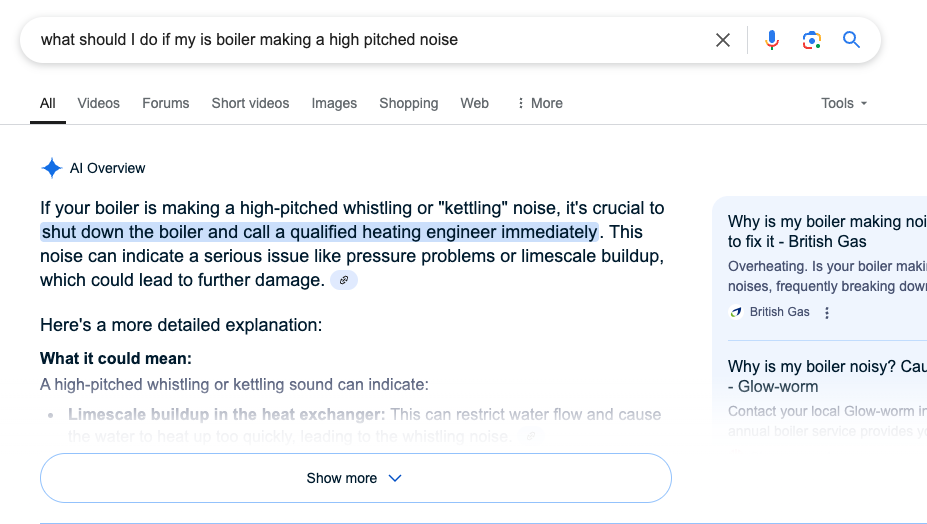
Straight away, before even doing the search, I know with a high amount of certainty that Google AIO will answer it.
The user might of been hoping for 'advise' such as "turn it off and on again" but in reality they need to call an engineer to sort it out. Google even highlights that point in the AIO.
The blog posts and pages which sites have created over the years of course appear below, but the chances of anyone now visiting those site just to be told what they now already know if pretty slim.
From Top Of The Funnel To Bottom Of The Funnel In 1 Search
What is more likely, is that they will enter something like heating engineer near me or heating engineer [your location]. That of course brings an entirely different SERP.
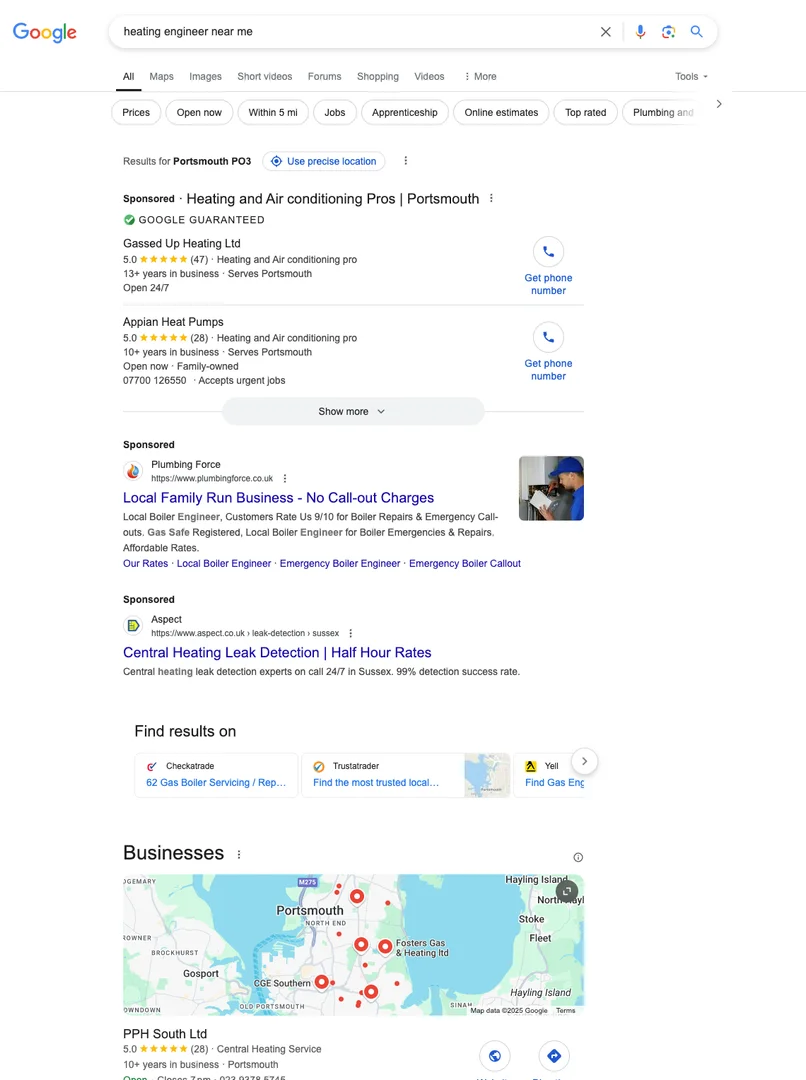
The resultant SERP is very much bottom of the funnel, locality-related content. Of course, dominated by Ads, in this case, LSA's (Local Search Ads), followed by standard ads and then the local map pack. This is something I will cover further down.
What Terms Will Appear For An AI Overview?
Let's be clear about something: Google's AI Overviews don't appear randomly. They're strategically placed to capture specific user intents.
If you're tracking your keywords and wondering why traffic is dropping for informational content, here's your answer: AI Overviews are absolutely dominating the top of the funnel searches.
Take a look at the data:
- Nearly 74% of problem-solving queries now trigger these AI summaries
- About 30% of searches overall include an AI Overview
- Mid-range, moderately complex queries are most likely to show them
Sound familiar? It should be because this is exactly the trend I highlighted earlier with the "boiler making high-pitched noise" example. Google knows that users want quick answers to these types of questions, and they're serving them up before you even have a chance to scroll.
Google's New AI Intent Filter
Google isn't just randomly deciding when to show these overviews. Their systems are actively determining whether generative AI can "enhance" the search experience.
What does this mean in plain English?
Google is looking for queries that:
- Require information from multiple sources
- Benefit from having someone (or something) synthesize a summary
- Match those classic "how do I..." or "what is..." patterns
And guess what? These are the EXACT keywords many SEO's have been targeting for years with their blog content strategy. The keywords that were supposed to fill the top of your sales funnel.
So again, the point I'm trying to make here is that back in the day when I first started this in 2011, it was all blue links with a couple of ads. SEO was easy. You would optimize the website, the client would rank, they would get traffic, they would get conversions. It was a symbiotic relationship because you were helping them make money, so they were happy to pay you money.
The North Star Metric: I Make My Clients Money
What's happening in the SEO industry is somewhere along the line; many SEOs forgot that their role is to make their clients money and focus solely on visibility. If your make your clients money, you will make money too. But the problem is that doing SEO the traditional way, trying to just rank in the organic listings, there's not nearly as many opportunities anymore. There's very little real estate. Google is squeezing that out. They don't want you to rank there. They don't care if you rank there. They're pushing ads, other products, forums, AI overviews.
And again, if you're just following that same linear process—build content, tactical optimization, build links—thinking that you're going to get results for your clients in 2025 and beyond, you're foolish. You're out of business. You just don't know it yet.
You have to make this your North Star metric: If you make your clients money, you'll make money too.
Is SEO Dead? No, But You Need to Adapt
So does that mean SEO is dead? Does that mean it's over? Absolutely not. But if i'm going to make my clients money, the best way to do that is focusing on local SERPs and also local ads, which I am going to talk about. So, adopting a blended search model and hyper-focusing on local businesses, specifically high-ticket local service businesses.
To drive this home, let's look at a SERP result for "divorce solicitor London" (for those in the US a Solicitor in the UK is the same as a Lawyer / Attorney) I personally work with law firms a lot, both here in the UK and in the US, it's a challenging market, but hey, that's what I live for!
When we type this in, the first thing we see are these local service ads. Then we get three sponsored results, then we get an AI overview with brand mentions AIO (something I will cover in a different post), the Google Maps pack, followed by PAA and then finally, underneath, we get the traditional SEO results.
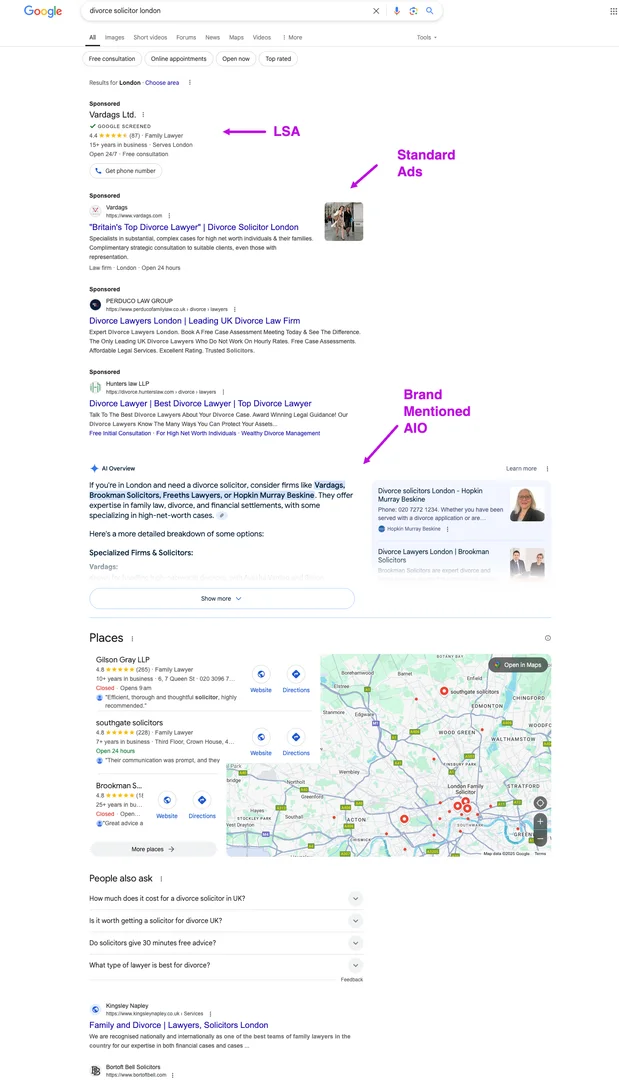
Now, I have a tremendous amount of data on this because of my work with law firms I have a very keen interest on the search results for many search terms both in the UK and the USA. I can tell you firsthand that ranking in that Google Maps pack, that local SEO result, drives millions of pounds or dollars in revenue for law firms.
I also know that trying to rank them down at the bottom in the traditional organic results does NOTHING. The reason why we pivoted to this model was because we were hearing nonstop from our clients: "Hey, great, we're seeing our traffic and keyword rankings go up and to the right. That's awesome. But we're not getting any more phone calls. We're not getting any more results. We're not signing any more cases. Why is that?"
Because those keyword graphs from Ahrefs and SEMrush show they're getting more traffic hypothetically, and they're getting better keyword rankings. But very few people are scrolling past the local service ads, past the maps pack, to come all the way down here, open five different results, and then read all the content when everything they need to make a decision about who to hire is right there in the maps pack.
There are reviews, a map showing proximity, and the ability to compare businesses. This is where you want to be. And if you can get somebody ranked in here, they're literally going to get phone calls off the hook. We have data that shows our clients ranking in the map pack get anywhere from 50 to 200 phone calls, depending on the volume in the location. Of course London, or New York are going to be busier than a small town in <50k population.
The more competitive the market you are working in, the harder the tasks are going to be. But the fundamentals of SEO remain. Quality content, written by Authority to cater for E.E.A.T and backlinks. Digital PR goes a long way in creating backlinks from authoritative sources go a long way and you need to be reactive for these types of links. Something I will cover in a different post.
The Local Search Goldmine: Maps Pack + Local Service Ads
This is relevant to nearly all businesses models though. I won't keep sharing screenshots but another search result: "air conditioning repair london" We see the LSAs on top, several ads, no AI overview this time, and again the maps pack. This maps pack is very prevalent. It's showing up. It's a protected asset that Google wants to show in these types of SERP results.
So by no means am I saying the SEO model is dead. But what I am saying is that if you're trying to attack SEO the traditional way and you're trying to be a jack of all trades, your clients aren't going to make money. If you don't make your clients money, you're not going to make money.
It is the North Star metric that should be for your business: how do I make my clients more money? Because if you can do that, you will make money. To me, local SEO is the best way to do that. And to get a little more surgical with it, if we mix in local service ads, which sit right at the top of the SERPs, it's the fastest way to drive more phone calls to any type of local service business.
The Blended Search Model: Immediate + Long-Term Results
Let me talk about this traffic graph here. This is what I call the blended search graph. This is what I show to all my prospects.
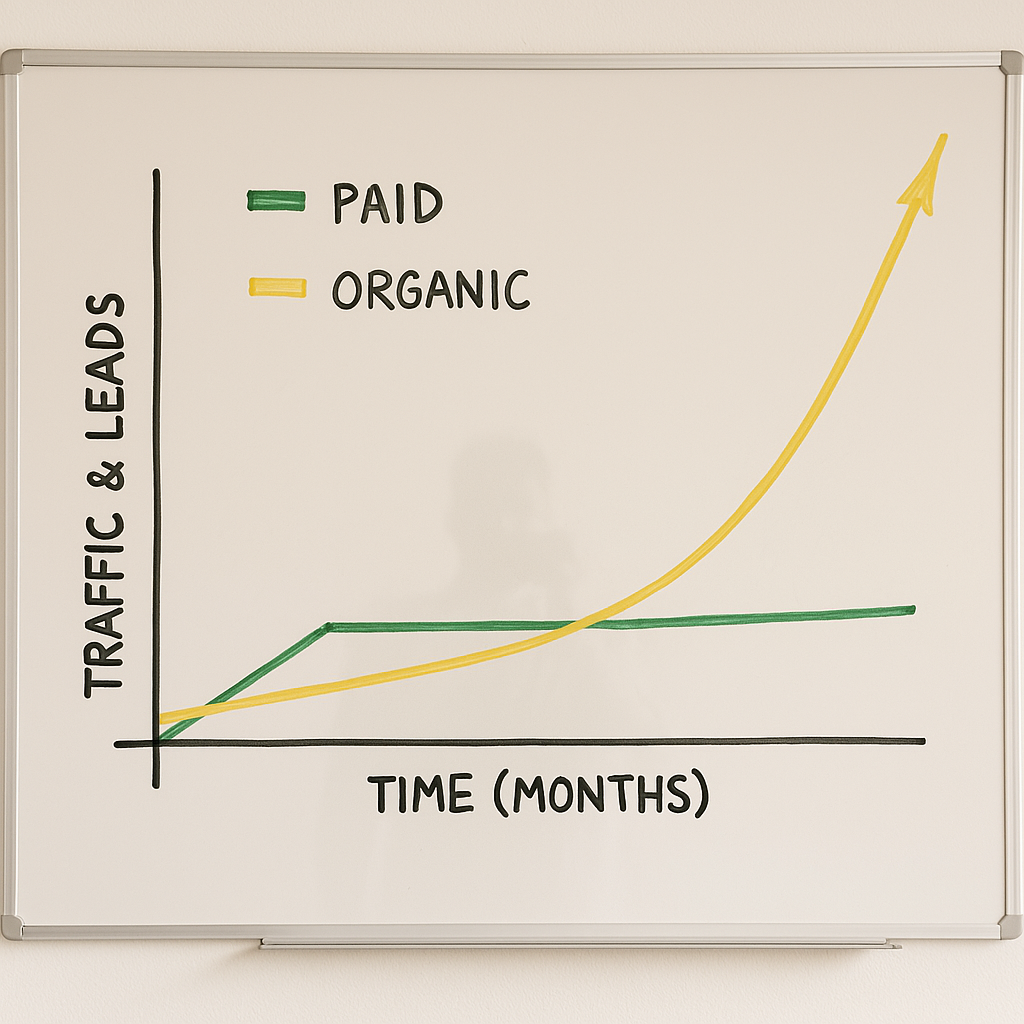
On the left-hand column, we have traffic and leads going vertically. And then over time here, we have time in months. In orange, we see the organic graph. The organic graph takes time to get results in terms of traffic and leads. But over time it starts to hockey stick.
The challenge you have as an agency is getting clients to buy in and give you the time to do this. The bigger problem you're having is that you're selling something to them, and you're doing SEO in a way that's never going to return any sort of leads. It might get some keyword rankings and traffic, but it's probably never going to deliver sales and results because, again, those results are jammed down at the bottom.
Now, if you're doing local SEO, I guarantee you that those traffic and, more importantly, those leads and phone calls are going to come.
When we add in paid search or local service ads, which is a form of paid search, what we get is a graph that spikes very quickly in terms of traffic and leads and then plateaus over time, because the number of keywords you're going to target is limited, usually by budget.
But what this does is it buys you so much time on the organic side of things. So when you offer these two services together, you're getting those phone calls and leads right away, and then you're giving yourself time to get this hockey stick growth. Over time, you can either taper down the paid component or go after new keywords.
It's this beautiful symbiotic relationship that you as an agency need to understand, adopt, and adapt to because, again, if you're not making your clients money, if you're not doing so quickly, you're going to fail.
Step 1: I Sell the Outcome
This is a very simple concept: Don’t sell the paintbrush, sell the masterpiece. People don’t care about the brush—they care about the picture they’re creating. They just want the outcome.
You will see so many freelancers and agencies selling intricacies of their work in some sort of power play that portrays expertise. Stop saying, "We do keyword research and link building." A Law Firm or Air conditioning repair company doesn't care about that. They don't even know what that is. They care about results. They want phone calls. They want leads. They want money in their bank account.
Clients don't care about spreadsheets. They just want revenue and growth. This is holding you back because deep down, you know that your service doesn't result in more conversions. That's a huge problem. You know you can't say, "Hey, we get leads for law firms," because you don't. So you're stuck saying, "We do SEO and we'll improve your rankings." They don't care about rankings! They're running a business. They want to make money.
When I have a conversation with my law firm clients, I'm showing them numbers. I'm saying, "This is the search volume in your market. If and when we rank you in the Google Maps pack, this is how many phone calls you can expect. With the local service ads, this is what it'll cost you, and this is how many phone calls you can expect."
Let's talk about your sales conversion rate. If I get you 100 phone calls a month, how many will you close? They say 10. Great, 10%. Ten new clients times £10,000 is £100,000 in revenue for the business. So if I send them a bill for £10,000-£20,000, do you think they're going to push back to hard on that? Of course not, because I showed them the value.
Of course, smaller businesses have smaller target areas or potential clients but prices are reflected on that. The numbers I am quoting above are for established law firms in busy cities like London, Manchester, New York or even Dallas.
You're not able to charge more because you're not driving more results. You're not driving more because you're not making that the North Star metric of your business.
Step 2: I Start with Local Service Ads
If you're not familiar with LSAs, they're the Google Guaranteed or Google Trustworthy listings that show up first in search results. They're tied to a Google Business Profile. Think of it like a boosted post on Instagram—it puts clients right at the top of the SERPs.
The best part is these are pay per lead. You have a high-intent lead, a high-intent search at a controlled cost. You're going to go right to the top of the SERPs. And since they operate on a pay-per-lead model, you know ahead of time what the budget should be to get the outcome they want.
If you go to Google and search "LSA calculator," it will let you select the category and tell you the estimated cost per lead. It varies by market, but for my personal injury clients, it's around $300 per phone call.
So if a client tells me they want to sign 20 new cases a month, I can do the math and show them what that's going to cost. I can build this equation much easier because I know what the lead costs through LSA. If I know their sales conversion rate, I can sell them through that.
Even better, LSAs are super easy to set up. You can do them yourself or find a cheap contractor. They're not like PPC ads—they don't take a lot of expertise or certification. The same person doing your local SEO can do your LSAs if they know their onions.
Most importantly, SEO takes time to get results. If you want to sell results, you need to get results, and LSAs will buy you that time. If their phone is ringing, they won't care how long SEO takes because they're looking at it as a total investment.
The standard investment is between £3,000-£10,000 a month for us to do LSAs and SEO, plus another £3,000-£8,000 in ad spend. So £6,000-£18,000 in total to engage with me. That might seem like a lot, but for lawyers, it's not, because I'm showing them how many phone calls they'll get. They'll start with a guaranteed minimum of 25 phone calls a month, potentially reaching upwards of 200 per month for every location.
I know this industry so well. If you work with a single vertical, you'll know this too. You'll know the business, what their cost per client is, what they're willing to pay, and this will become so much easier to sell, deliver, and get results for your clients.
Step 3: Strictly Follow a Process
Ranking in Google isn't a secret anymore. People ask me all the time, "How do I do X, Y, and Z for local SEO?" I tell them, "It's not rocket science. You can ask ChatGPT how to rank in Google Maps, and it's pretty accurate."
There are no hacks anymore. What SEO comes down to today is activity. You just have to do the work. You have to find somebody, hire somebody, or train them to do the work. The best way is to have a documented process. With a documented process, you can easily find and train people at a very low cost.
Here's the high-level optimization process:
- Optimize the Google Business Profile - photos, titles, products, services, posts, etc. You can even use AI to automate much of this. But always double-check everything.
- Get reviews - This is easier said than done. We have a five-step process for our clients to get reviews from past customers, set up automations, reach out to friends and colleagues.
- Set up the website with the right content and architecture to support local rankings.
- Acquire good links, ideally local links - Reach out to local press outlets, legal publications, etc.
It's very similar to a traditional SEO process, but we're focusing much more on the local side of things.
The Bottom Line
The SEO environment has changed dramatically. Agencies and freelancers must adapt or die. Traditional organic rankings aren't enough anymore—not when Google is pushing ads, AI answers, and local results to the top of search results.
If you want to thrive in 2025 and beyond, you need to:
- Sell outcomes, not SEO tasks
- Use a blended approach with Local Service Ads and local SEO
- Follow a documented process
Remember your North Star metric: make your clients money, and you'll make money too. If you're delivering real business results—phone calls, leads, and revenue—you can charge premium prices and keep clients for life.
The future of SEO isn't in chasing algorithm updates or building more backlinks. It's in adapting to the new reality of Google's SERPs and focusing on what actually makes your clients money. That's how I work with my clients and I truly wish other would do the same.